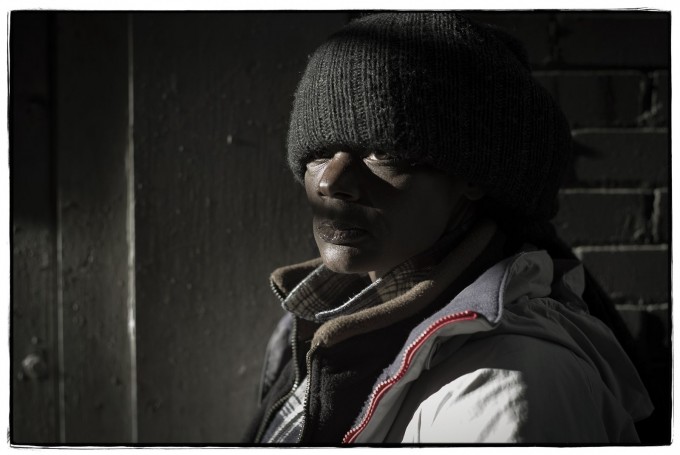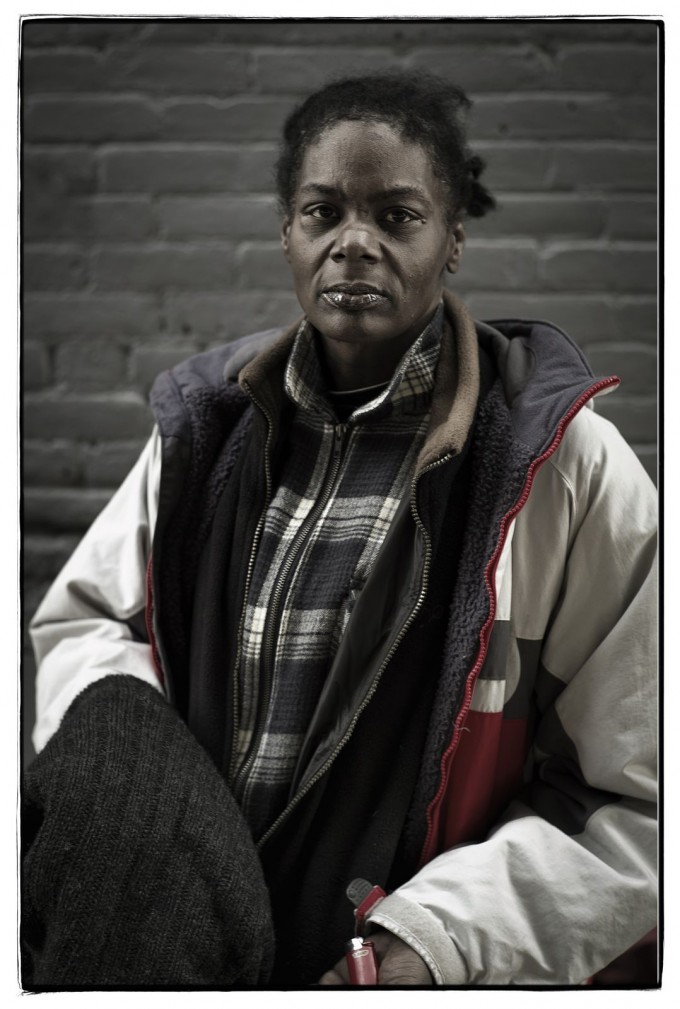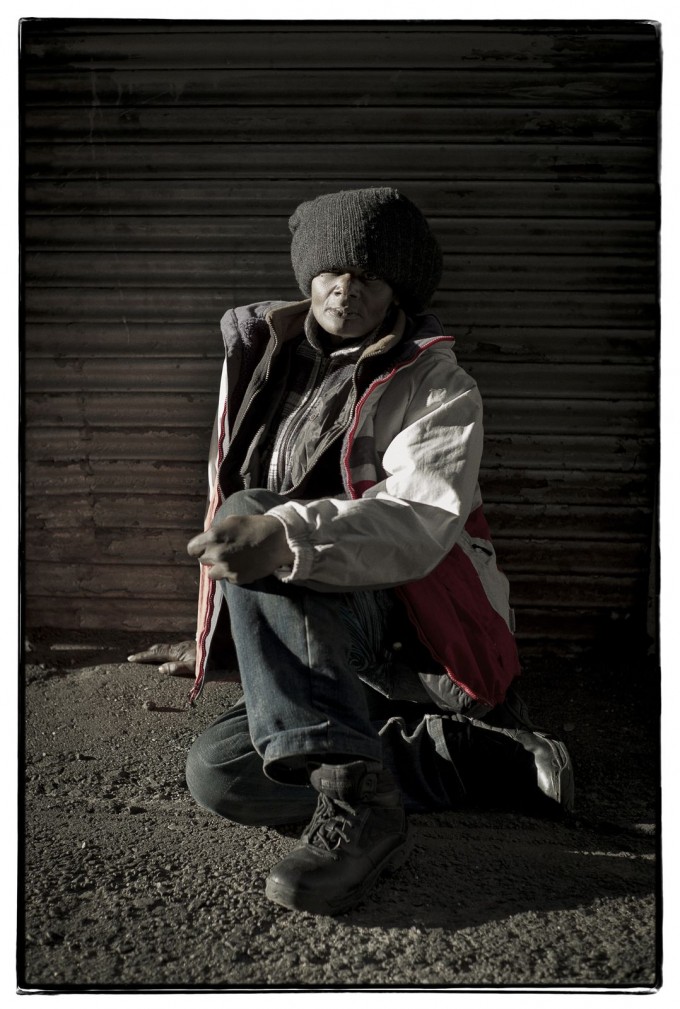Hi Steve,
I’m sure you are quite busy with the holidays as well as keeping up with the website. However, I figured I would share some more photos with you, and your readers as well.
So, I was shooting around in the alleys of Denver today, and was approached by a woman named Sherri, who was obviously looking for some money and food. I had only a few dollars in my pocket, and although I was taken aback by her persistence and intensity, I decided to offer her a deal, and exchange a few dollars for the opportunity to shoot a few photographs of her. She agreed, and I took some photos. I try not to shoot the homeless, as I feel exploitative for some reason, but I went ahead with my photography and composed, metered, and shot with my M9 and 50mm Summilux pre-asph (E43 version).
After photographing her, and being quite pleased with the results, I started to feel an even greater feeling of exploitation. I did give this woman some money, in hopes that she would get something to eat, but the photograph is a strange thing. It seems to take a lot more than it provides in this situation. If I could give her a print, would that help? If I portray her as she is, is she helped or hurt? Then I started to think of where my photographs would end up. I post my photos mostly on Flickr, Rangefinderforum, and a few Leica sites. But it makes me wonder a bit as I’m photographing someone who no doubt has little or no access to the internet. She will never know where her images are floating around, and will never know the impact they have on someone. Perhaps these are the ethics and morality of photography in general, but I can imagine that I’m not alone in this.
I’d be very interested in hearing your own responses, as I know you spent some time shooting the homeless years back (gallery here). Readers of your site have no doubt run into similar dilemmas, and I figured I would put my thoughts out there, with a few images of my experience with Sherri.
Thanks very much Steve and best wishes in the New Year…
Jordan Dickinson
–
From Steve: Thanks for the submission Jordan. To many this is a touchy subject matter. I myself photographed the homeless a few years back and it turned into a rewarding project for me. I met many great men and women who lived on the street and I learned their stories. I helped them with food, money and blankets and they were all so grateful. I visited with many on multiple occasions and since then a few of them have passed away. I looked at what I was doing as more about “awareness” than exploitation. As long as you are not out there “sniping” them with a 200mm lens and you talk with them and ask them permission then I feel it is perfectly fine. My gallery has been posted in newspapers, magazines and linked to at many online sites. I did not gain anything from what I did but I was able to help many men and women and bring some awareness to the issues. Again, thanks for the photos and the story.





‘Your images have made me think of the less fortunate and their plight this holiday season, that is certainly a good thing.’ To whom and why is that a good thing? What is net effect? I think for it (‘thinking’) to be a truely ‘good thing’, thinking ought to be converted to action. But what action?
I too have felt that wayJordan…
I try to ask and offer them something before taking their picture. Unfortunately that opportunity isn’t alway available, which makes me remorseful….like in this picture…taken in NYC this summer.
[img]http://grs614.zenfolio.com/p44318891/h1bb00d13#h1bb00d13[/img]
On the question of exploitation…
I doubt that Sherri feels like she exploited you, she was persistent and you came to a business arrangement. The experience will undoubtedly change your life much more than it will hers, but I don’t deem that to be exploitation either. The key to answering the question, “Was she taken advantage of?” from my point of view is answered by your simply knowing her name. She isn’t an anonymous person, she is Sherri and you treated her with kindness. And the photos portray that as well.
BTW – if someone is really abrasive about this type of work, ask yourself… “How many homeless friends do I have?” and “Why?”
I am sitting in my warm and comfortable office. All day thinking about “making money”. But outside my office there is another world that I often drive too easily away. Thank you for the pics.
The decision of what our cameras records is a personal choice and with that being said the decision of what our camera doesn’t record is a personal choice. How we use our images is even more important, I’ve walked away from a lot of images in my life and never regretted any of them. Your images have made me think of the less fortunate and their plight this holiday season, that is certainly a good thing.
Well put.
In Wellington, the capital of New Zealand, we have a man designated “blanket man” he is a true character. I will never consider photographing him unless he asks 🙂 I truly believe that those who are challenged deserve our respect and their space. I don’t believe these people are tragic, it’s simply part of life, not always pretty but always there. I love this quote . . .
“Happiness is always a by-product. It is probably a matter of temperament, and for anything I know it may be glandular. But it is not something that can be demanded from life, and if you are not happy you had better stop worrying about it and see what treasures you can pluck from your own brand of unhappiness”
– Robertson Davies
Go with your gut, the only thing you can ever really count on.
I really dislike when people exploit the homeless. In this case, though, you captured her beauty. I’m impressed.
Thanks for all your comments and insights. My intention of posting these images and story was to spark this very conversation, and I really love all the discussion. I suppose my main point of bringing this issue to attention has been best addressed by Armanius in trying to distinguish between street photography and the overly content aware photographer. I agree that I don’t think there should be a difference between a homeless person and an affluent sidewalk shopper. However, I feel that sometimes I am confronted with the challenge of how to portray each person as human, and not merely as a stereotype of class or circumstance. One of the most interesting moments of my experience with this woman was that once I started to photograph her, she almost “posed” as homeless, showing me her change in hand, and sitting down against the wall as if to show in the photograph her condition. I don’t think this is necessarily a bad thing, but I do wonder if she thought the intention of my photographs were to document a homeless woman rather than just a woman. Perhaps, as photographers, we all see this kind of response to our cameras from time to time. I just hope my interaction with her was understood as person to person, rather than just photographer to homelessness.
In any case, thanks very much again for the comments. I appreciate them very much.
If you hadn’t taken the photographs it’s likely the world would never have known she existed. That is the tragedy.
Jordan,
First, nice photos. That was the easy part!
As for the issue of exploitation, I guess the question is what are you or anyone else that takes a photo of a homeless exploiting that homeless person for? Fame? Fortune? Satisfaction that you took a nice photo? Or maybe there’s really no exploitation at all?
If someone is into street photography, what makes taking a photo of someone who is affluent different than a photo of a homeless person? I think of Chris Week’s excellent video and its name “Street Photography: Documenting the Human Condition”, and wonder if a photographer should document only parts of the human condition while avoiding others.
What about war time photographers that document the horrors of war? Many award winning photos depict some horrible atrocities. Are they exploiting the victims of war?
I’m just throwing out questions out there, and I’m not sure if there is a real clear cut answer. There probably isn’t. I do believe most people who have some money, a roof over their heads and a warm bed at night do feel some sense of guilt when confronted with homelessness. I know I do. As we approach that stop sign, we avoid making eye contact with the man standing there. Sometimes I give money but sometimes I don’t. If I give it out of guilt as opposed to compassion, am I exploiting that man?
Jordan, whatever you did, I am glad that you engaged that woman as a human being. You could have avoided her, but you didn’t. You could have told her to scram. But you didn’t. You could have not given her any money. But you didn’t. In my book, you have done good. Take your photos, and I propose to let them be reminders to you (and all of us) that there are people who are not as fortunate, and who need help. If your photos help remind us of that, I would submit that it’s not exploitation.
Powerful pics, Jordan. On the other note, I would have asked her permission to have her pictures posted on the net. There are women who are homeless because they are trying to escape–such as from abusive people/person in her life. Putting their pics on the net with (possibly her real name) could potentially be harmful.
Jordan
These are truly wonderful images of this woman, and I feel they show her with a lot if dignity and respect. Rather than being exploitation, I would say that they are more documentary. Though as some of the comments here are showing, this is a touchy subject. I suggest that you make some small prints to give her so you may continue the relationship, and ask her if you may give copies to the local shelter. You may be at the beginning of a project that may open a new avenue of photography for you. Take care, and keep us informed.
Good post (and great photos). It’s a complex issue – there is a strong tradition of social documentary photography which has helped alleviate myriad issues. If you accept this, then it’s the intentions of the photographer that determine whether it ‘acceptable’. Anyway, morality rarely sits easily with Art and it’s difficult (and maybe not desirable) to pass judgement on what’s acceptable and what’s not. If you want to get sniffy about photographing the poor, then I suggest you consider the travel portrait photography of equally poor and unempowered people, which are seemingly more acceptable because they are colourful and foreign. I suggest a bigger issue is the morality of photographing poor people with an overpriced M9. For those of you critical, or with a troubled conscience, you could sell your $9000 Leica kit, get a used FM2, and donate the money to a homeless charity.
In any case, this lady is certainly worthy of an Inspiration post because she has a powerful face which has produced a strong portrait. For me, I am pleased to witness her presence and see this image.
I think that the very fact that you communicated with this homeless woman named Sherri, and did not pass by with averted eyes like most of us would do, should alleviate any desire for soul searching on your part.
You have given this woman a certain dignity in your photographs, and as DJDLV mentioned documenting plight can raise awareness, if done with sensitivity and compassion.
Lots of good can come out of things like this as I have seen it and experienced it. Awareness is much different than exploitation.
I don’t like photographing the poor and destitute at all, unless it’s your job. Exploitative is the operative word.
Jordan, you can’t hope for salvation by sending your pics to this blog and telling us something about your soul’s pain. Whenever I don’t feel alright with the context of a photo, I delete/destroy it.
Beautiful and tragic. Well concidered and photographed. Documenting plight can always raise awareness so it surely must be a good endeavour.
Jordan, This was very well written. you hit the nail on the head. I think about this as well. I don’t usually photograph the homeless. I think it’s a good project to do if it brings awareness to the public in how to help the situation. I am like Steve in that i don’t think I’d accept payment for it, but would do it as an awareness campaign. Although, if money were accepted for such a project, it could also be donated to soup kitchens or other homeless charities. Now that would be cool. She is very photogenic, by the way.